Sharanabasappa Saddu1*, Sangshetty Kivade2 and Ramesha Devarahalli3
1VTU Belagavi, Karnataka, India
2Basavakalyan Engineering College, Basavakalyan, India
3Mechanical Engineering, UVCE, Bangaluru, India
Corresponding Author:
Sharanabasappa Saddu
Research Scholar, VTU Belagavi, Karnataka, India
Tel: +8884820707
E-mail: sadduss@rediffmail.com
Received Date: December 17, 2018; Accepted Date: January 04, 2019; Published Date: January 08, 2019
Citation: Saddu S, kivade S, Deverahalli R (2019) Performance and Emission Parameters of Compression-Ignition (Ci) Engine Fuelled with Waste or used Temple Oil Biodiesel at Blends. Int J Appl Sci Res Rev. 5:18. DOI: 10.21767/2394-9988.100083
Keywords
Biodiesel; Used temple oil; Ultimately wasted; Blend, Performance; Injection
Introduction
Industrialization and population explore and also extensive use of petroleum fuels led to scarcity of petroleum fuels. This increased the importance of biodiesel fuel. Biodiesel is recommended as a renewable, sustainable efficient and cost effective fuel. It has become one of the promising alternative fuels. Due to the potentiality of a sustainable energy mix in the future and it can be produced by non edible oil feedstock [1]. There are two types of biodiesel they are edible and non edible oils. Sunflower, corn, rapeseed, palm, soybean and waste vegetable oils are edible oils. Oils from Jatropa, Jojaba, Karanja, Polanga are non edible oils. These are oxygenated, biodegradable, non- toxic and environmentally safe. Therefore bio fuels are getting much importance and many scientific efforts to be produced in economical, available, safe and environment friendly nature [2]. Due to the easiest availability on large scale from agricultural, biodiesel from edible vegetable oils has been produced in all over the world more than 95% [3]. Currently in Canada biodiesel is produced from rapeseed, in US from soybean, in Europe from sunflower and in Southeast Asia from palm. Biodiesel from waste cooking oil is the best substitute to petroleum diesel which can solve the petroleum of environmental pollution and scarcity of energy and this would be produced with low cost, than any other edible and non edible oils [4].
Emissions of CO, smoke density and NOx reduced on average 80%, 50% and 26% respectively when karanja methyl ester with diesel [5]. The BSFC was increases with the increase of blending ratio in the blended fuel of waste cooking oil methyl ester. As compared with standard diesel and B5, B20 blend in Compression ignition engine found to be reduction in the CO. For fuel economy B20 blends were found to be good [6]. The result of experiment proved that combustion of B5 and B20 of biodiesel of waste cooking oil was same with diesel in the in the cylinder combustion pressure. Due to its properties B100 shows a large difference with diesel [7]. By using NOME (Neem Oil methyl ester) blend B20, B30 and diesel are 28.32%, 27.69% and 26.74% respectively at full load condition of brake thermal efficiency of IC engine. As compared to B30 and diesel the efficiency of B20 blend was higher. As compared to diesel exhaust emission such as CO (carbon monoxide), HC (Hydro carbon) are decreased with NOME blends. NOx emission for B30 and B20 are higher as compared to diesel. B20 blend gives better performance emission and combustion characteristics as compared to B30 and diesel [8].
It was found that BTE of waste cooking methyl ester (WCME) and its blends is slightly lower as compared with diesel. The BTE of WCME is 26% but of diesel fuel is 30%. Emission of Unburned hydrocarbon decrease when WCME blend increases [9]. For soybean methyl ester (SME) bends BSFCs were higher than for diesel fuel and B20 SME gives the same performance compared to diesel fuel [10]. Many Indians as per their ritual and religious belief pour oils on the idols and for lamp in temples. This oil is wasted and cannot be reused. This waste temple oil from Shani Shingnapur was used to produce biodiesel. By chemical and biological method waste temple oil can be converting into biodiesel through transesterification process. Characteristics of biodiesel were studied, the yield obtained was 96%. To study the quality of biodiesel, clarity tests were conducted. Comparing with diesel fuels, it is renewable alternative fuel with low toxicity [11].
There are innumerable temples in India, counting them is puzzle. As per the tender advertisement by Department of Muzrai, Government of Karnataka, the used temple oil potential at Shree Renuka Yallamma Temple Soudatti, District Belagavi, for the year 2016-17 is 18900 kg. This is oil potential from one temple only. In this present investigation biodiesel is prepared from Used Temple Oil from Hanuman Temple near Marikamba Temple Sirasi, Uttarkannada, Karnataka. The performance and emission characteristics are evaluated on a AV1 Vertical, single cylinder, water-cooled, 4-stroke, compression ignition diesel engine.
Materials and Methods
Used Temple oil (crude oil), NaOH catalyst, Isopropyl methanol and Phenolphalein indicator are the main materials. Used Temple Oil was collected from Shree Maruti Temple in front of Shri Marikamba Temple, Sirsi, Uttar Kannada district of Karnataka state, India, having latitude 140 36’ 43” N and 740 50’ 22” E. The used Temple Oil is an unknown quantity mixture of ghee, edible and non-edible vegetable oils also.
The products formed during transesterification are used temple oil methyl ester and glycerin. The bottom layer consists of glycerin, excess alcohol, catalyst impurities and traces of un-reacted oil. The upper layer consists of clean amber colored temple lamp oil methyl ester. After settling, the glycerol layer is removed. Esterifies oil washed with water. The washing is carried out in a separate funnel. The separated biodiesel is used for characterization. The biodiesel yield is 94.51% after purification.
The physical properties of UTO (Used Temple Oil) and UOME (Used Temple Methyl ester) and different blends are determined and were compared with fossil diesel fuel as shown in the Tables 1 and 2. And the Values of UTOME have almost same properties as that of the diesel fuel and shows it can be used as an alternate fuel.
| Sl No |
Properties |
ASTM |
Diesel [7] |
UTO |
UTOME |
| 1 |
Density (kg/m3) |
870-900 |
846 |
910 |
870 |
| 2 |
Kinematic Viscosity
@ 40°C |
1.9-6 |
2.60 |
26.6 |
5.1 |
| 3 |
Flash point °C |
>130 |
52 |
202 |
164 |
| 4 |
Calorific Value (MJ/kg) |
- |
42.21 |
38.628 |
39.080 |
Table 1: Physical property of UTO and UTOME.
| Sl No |
Properties |
B20 |
B30 |
B40 |
B100 |
| 1 |
Density ( kg/m3) |
825 |
830 |
840 |
870 |
| 2 |
Kinematic Viscosity
@ 40°C cSt |
2.8 |
3.0 |
3.2 |
5.1 |
| 3 |
Flash point °C |
54 |
58 |
60 |
164 |
| 4 |
Calorific Value (MJ/kg) |
42.881 |
40.231 |
39.423 |
39.080 |
| 5 |
Fire point °C |
57 |
60 |
65 |
167 |
Table 2: Physical properties of UTOME at different blends.
Engine Performance and Emission Studies
The variations BTE with load for different fuels at 200 bar injection opening pressure is presented in Figure 1. The study shows that increase in BTE with increase in load for all the cases. The maximum BTE were obtained to be 29%. The BTE obtained for B30, B40 and B100 were 28%, 26% and 25% respectively. The variations BSFC with load for different blends were presented in Figure 2. For all the conditions BSFC decrease with increase in load. The BSFC of UTOME B20, B30 B40 and B100 and diesel at 75% load conditions are 0.25 kg/kW hr, 0.27 kg/kW/hr, 0.28 kg/kW hr, 0.29 kg/kW hr and 0.24 kg/kW hr respectively.
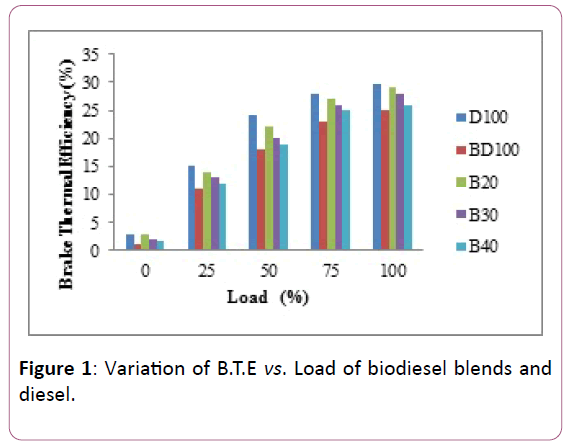
Figure 1: Variation of B.T.E vs. Load of biodiesel blends and diesel.

Figure 2: Variation of B S. F.C vs. Load of biodiesel blends and diesel.
The variation of CO (Carbon Monoxide) produced by running the diesel engine using UTOME blend 20 to blend 100 is compared with diesel in Figure 3. The emission of CO increases with load. The greater the load, the richer air-fuel mixture is burnt and hence more CO is formed owing to the oxygen deficiency. Lower CO values were observed for B20 and B30 blends as compared to diesel for all load conditions. The variation of HC (Hydrocarbon) emission is shown in Figure 4. It is observed that the variation of HC emission with different load conditions for blends are having same trends with diesel and the values are lower than the diesel. The HC emission values of diesel, B20 and B30 at 75% load condition are observed as 31 ppm, 28 ppm and 26 ppm respectively.
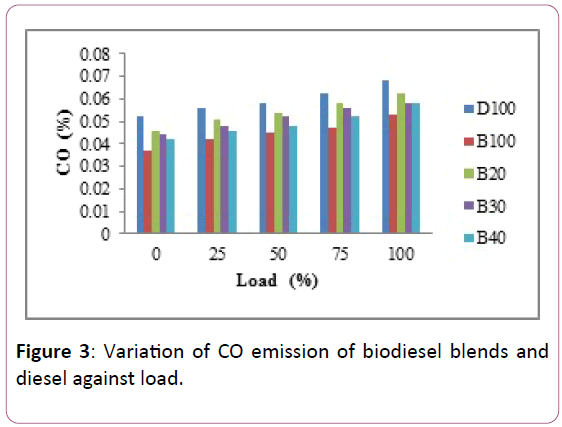
Figure 3: Variation of CO emission of biodiesel blends and diesel against load.
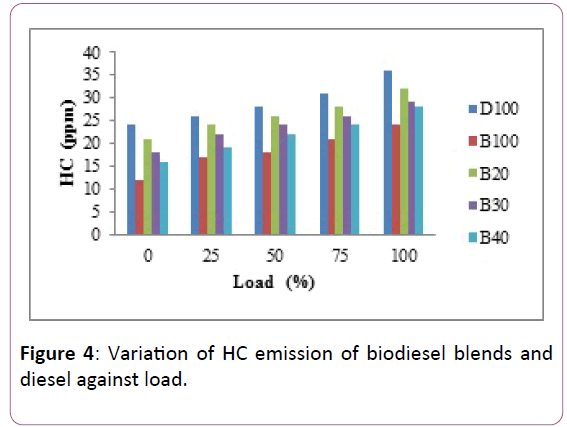
Figure 4: Variation of HC emission of biodiesel blends and diesel against load.
The variation of NOx emissions from UTO biodiesel with respect to diesel are displayed in Figure 5. The NOx emissions increased with the load for all UTOME mixture. The amount of NOx produced for B20 to B100 varied between 58 ppm to 493 ppm as compared 49 and 420 for diesel. The variation of smoke produced during the test for different fuels is presented in Figure 6. The average smoke opacity for B20, B30, B40 and B100 were less than diesel fuel. At 75% load the smoke opacity for diesel, B20 and B30 are 82%, 76% and 70% respectively.
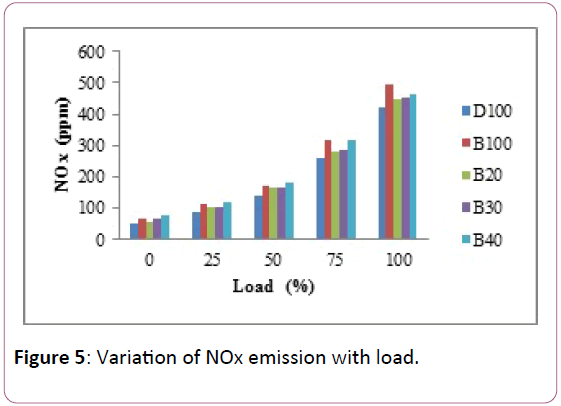
Figure 5: Variation of NOx emission with load.
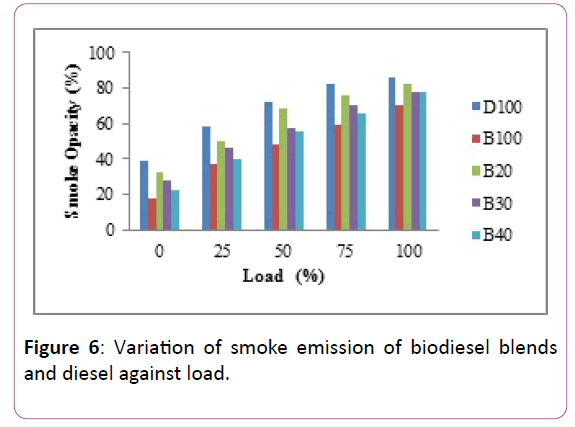
Figure 6: Variation of smoke emission of biodiesel blends and diesel against load.
Conclusion
The main aim of the study is to evaluate the Used Temple Oil as a potential raw material for the production of biodiesel and also evaluate its possibility for the substitute to petroleum fuel. Through transesterification method, the Used Temple Oil is converted into biodiesel successfully, characteristics are also done. The physical and chemical proportions were found well with the standard limits.
The diesel engine can perform satisfactorily on UTOME blends with diesel fuel without any engine modifications. CO, HC, and NOx emissions of UTOME are decreasing than diesel. The above proportions of the UTOME are as comparable with diesel fuel hence UTOME can be effectively used as alternate fuel for diesel engine.
References
- Bhuiy MMK, Rasul MG, Khan MMK, Ashwath N, Azad AK, et al. (2014) Energy Procedia 61: 1969-1972.
- Mohammed EK, Nemit-allah MA (2013) Experimental investigations of ignition delay period and performance of a diesel engine operated with Jatropha oil biodiesel. Alexandria Engineering J 52: 141-149.
- Gui MM, Lee KT, Bhatia S (2008) Feasibility of edible oil vs. non-edible oil vs. waste edible oil as biodiesel feedstock. Energy 33: 1646-1653.
- Ahmia AC, Danane F, Bessah R, Boumesbah I (2014) Raw material for biodiesel production. Valorization of used edible oil. Revue des Energies Renouvelables 17: 335-343.
- Raheman H, Phadatare AG (2004) Diesel engine emissions and performance from blends of karanja methyl ester and diesel. Biomass and bioenergy 27: 393-397.
- Gund SP, Kolhe KP, Ragit SS (2016) An experimental investigation of performance and emissioncharacteristics of a CI engine fuelled with waste cooking methyl ester and its respective blends withdiesel fuel”. Int jou of current Engg and Technology.
- Ramlan NA, Abdullah AA, Yahya WJ (2015) Combustion performance and exhaust emission Analysis of diesel engine using waste cooking oil. J Advanced Research in Fluid Mechanics and Thermal Sci 12: 11-20.
- Gopinath DE, Ganapathy S (2015) Experimental studies on performance and emission characteristics of diesel engine fuelled with Neem oil methyl ester blends “ International Energy J 15: 33-42.
- Gopal KN, Pal A, Sharma S, Samanchi C, Sathyanarayanan K, et al. (2014) Investigation of emission and combustion characteristics of a CI engine fueld with waste cooking oil methyl ester and diesel blends. Alexndria Eng J 53: 281-287.
- Al Dawody MF, Bhatti SK (2014) Experimental and computational Investigations for combustion, Performance and Emission parameters of a Diesel engine fueled with soybean biodiesel diesel blends. Energy Procedia 52: 421-430.
- chanda M, Desai P, Tamble A, Deikar SB, Mutalik KS (2017) Productionof biodiesel using waste temple oil from shani shinganpur temple (Dist Ahmednagar) Maharashtra, India using Chemical and biological methods. Int Jou of Env Agri Biotech 2: 1.







